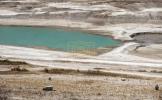

Iran is grappling with its most severe water crisis in six decades, with officials implementing rationing measures in the capital, Tehran, and warnings that evacuation of the city may become necessary. Only 7% of the country’s dam reservoirs remain filled, while 93% are depleted, and 19 major dams are at less than 5% capacity, underscoring the severity of the drought.
Authorities have already begun imposing night-time water cuts in Tehran to manage the dwindling supply. The president has expressed concern over the situation, highlighting the possibility that extreme measures, including evacuation, may be required if conditions continue to deteriorate.
Experts point to a combination of natural drought, wasteful usage, and mismanagement of resources as contributing factors to the crisis. Iran’s water infrastructure is under immense strain, with reservoirs such as Amir Kabir Dam—recently captured in footage—illustrating the alarming drop in water levels.
This historic drought threatens agriculture, public health, and urban life across the nation, forcing authorities to make difficult decisions on water distribution and long-term sustainability. As Iran faces what may be the worst water shortage in 60 years, officials and citizens alike are grappling with a growing humanitarian and environmental challenge.
גאלערי
ווידעאס